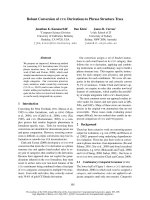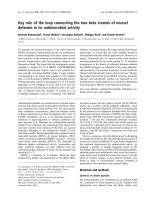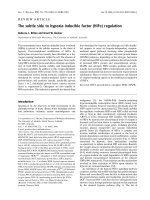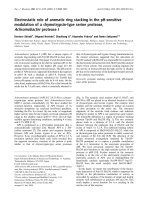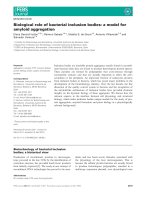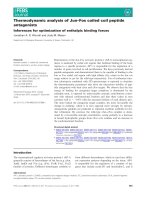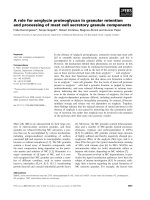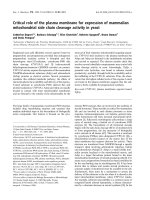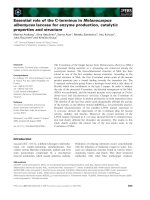Báo cáo khoa học: The role of glucose 6-phosphate in mediating the effects of glucokinase overexpression on hepatic glucose metabolism pdf
Bạn đang xem bản rút gọn của tài liệu. Xem và tải ngay bản đầy đủ của tài liệu tại đây (290.5 KB, 11 trang )
The role of glucose 6-phosphate in mediating the effects
of glucokinase overexpression on hepatic glucose
metabolism
Linda Ha
¨
rndahl
1
, Dieter Schmoll
2
, Andreas W. Herling
2
and Loranne Agius
1
1 School of Clinical Medical Sciences-Diabetes, The University of Newcastle upon Tyne, Medical School, Newcastle upon Tyne, UK
2 Aventis Pharma Deutschland GmbH, TD Metabolism, Frankfurt, Germany
Glucose 6-phosphate (Glc6P) is the first intermediate
in glucose metabolism and is generated by the hexo-
kinase-catalysed reaction. Hepatocytes express all four
hexokinase isoenzymes (EC 2.7.1.1), but predominantly
hexokinase IV, commonly known as glucokinase [1].
Glucokinase differs from the other isoenzymes by its
lack of inhibition by physiological concentrations of
Glc6P [2] and by its low affinity for glucose and sig-
moidal kinetics [1]. Accordingly, in the hepatocyte, the
cellular content of Glc6P responds to changes in both
glucose concentration and glucokinase activity [3]. The
latter is regulated by insulin and glucagon at the tran-
scriptional level [4], and by glucose, precursors of fruc-
tose 1-phosphate and hormones at post-transcriptional
Keywords
glucokinase activators; glucokinase; glucose
6-phosphate; glycogen; liver
Correspondence
L. Agius, School of Clinical Medical
Sciences-Diabetes, The Medical School,
University of Newcastle upon Tyne,
Newcastle upon Tyne NE2 4HH, UK
Fax: +44 191 2220723
Tel: +44 191 2227033
E-mail:
(Received 25 August 2005, revised 15
October 2005, accepted 18 November
2005)
doi:10.1111/j.1742-4658.2005.05067.x
Pharmacological activation or overexpression of glucokinase in hepatocytes
stimulates glucose phosphorylation, glycolysis and glycogen synthesis. We
used an inhibitor of glucose 6-phosphate (Glc6P) hydrolysis, namely the
chlorogenic derivative, 1-[2-(4-chloro-phenyl)-cyclopropylmethoxy]-3, 4-di-
hydroxy-5-(3- imidazo[4,5-b]pyridin-1-yl-3-phenyl-acryloyloxy)-cyclohexane-
carboxylic acid (also known as S4048), to determine the contribution of
Glc6P concentration, as distinct from glucokinase protein or activity, to
the control of glycolysis and glycogen synthesis by glucokinase overexpres-
sion. The validity of S4048 for testing the role of Glc6P was supported by
its lack of effect on glucokinase binding and its nuclear ⁄ cytoplasmic distri-
bution. The stimulation of glycolysis by glucokinase overexpression corre-
lated strongly with glucose phosphorylation, whereas glycogen synthesis
correlated strongly with Glc6P concentration. Metabolic control analysis
was used to determine the sensitivity of glycogenic flux to glucokinase or
Glc6P at varying glucose concentrations (5–20 mm). The concentration
control coefficient of glucokinase on Glc6P (1.4–1.7) was relatively inde-
pendent of glucose concentration, whereas the flux control coefficients of
Glc6P (2.4–1.0) and glucokinase (3.7–1.8) on glycogen synthesis decreased
with glucose concentration. The high sensitivity of glycogenic flux to Glc6P
at low glucose concentration is consistent with covalent modification by
Glc6P of both phosphorylase and glycogen synthase. The high control
strength of glucokinase on glycogenic flux is explained by its concentration
control coefficient on Glc6P and the high control strength of Glc6P on gly-
cogen synthesis. It is suggested that the regulatory strength of pharmacolo-
gical glucokinase activators on glycogen metabolism can be predicted from
their effect on the Glc6P content.
Abbreviations
Fru2,6P
2
, fructose 2,6-bisphosphate; Glc6P, glucose 6-phosphate; GKRP, glucokinase regulatory protein; MEM, minimal essential medium;
PP-1, protein phosphatase-1; S4048, 1-[2-(4-chloro-phenyl)-cyclopropylmethoxy]-3, 4-dihydroxy-5-(3-imidazo[4,5-b]pyridin-1-yl-3-phenyl-
acryloyloxy)-cyclohexanecarboxylic acid.
336 FEBS Journal 273 (2006) 336–346 ª 2005 The Authors Journal compilation ª 2005 FEBS
levels through the interaction of glucokinase with bind-
ing proteins [5,6]. The glucokinase regulatory protein
(GKRP) is a specific inhibitor of glucokinase [5] and
also a nuclear receptor that sequesters glucokinase in
the nucleus at low concentrations of glucose [7]. Its
affinity for glucokinase is decreased by fructose
1-phosphate, which causes translocation of glucokinase
from the nucleus to the cytoplasm [5,7]. Conditions
that cause dissociation of glucokinase from GKRP are
associated with a parallel increase in the cell content
of Glc6P, confirming the regulatory role of GKRP on
glucokinase activity [8]. Recent studies have identified
small molecule activators of glucokinase that bind to
an allosteric site and markedly increase the affinity
for glucose [9–11]. These compounds, unlike fructose
1-phosphate, do not dissociate glucokinase from
GKRP in solution, but nonetheless cause transloca-
tion of glucokinase from the nucleus. They thereby
impact hepatocyte glucose metabolism by direct
activation of glucokinase and by altering its subcellular
location [10].
In the liver cell, Glc6P is an intermediate of various
metabolic pathways and a substrate for glucose
6-phosphatase [12]. It is also a key regulator of glyco-
gen synthase [13] and phosphorylase [14], and is impli-
cated in the transcriptional control of glycolytic and
lipogenic genes [15]. The effect of Glc6P on glycogen
synthase, which is regulated by multisite phosphoryla-
tion, involves a hierarchy of mechanisms [13]. Glc6P is
an allosteric activator of glycogen synthase and
thereby increases the enzyme affinity for its substrate,
uridine 5¢-diphosphoglucose (UDP-glucose), but it also
favours a conformation of the enzyme that is a better
substrate for dephosphorylation by protein phospha-
tase-1 (PP-1). The affinity of glycogen synthase for
Glc6P increases with dephosphorylation, leading to
further activation [16]. Glucose has an analogous (but
converse) role on phosphorylase. It causes allosteric
inhibition of phosphorylase-a (the phosphorylated act-
ive form) by favouring the tense (T) conformation,
which is also a better substrate for dephosphorylation
by PP-1. As the dephosphorylated form (phosphory-
lase-b) is catalytically inactive in liver [17], glucose cau-
ses both allosteric inhibition and covalent inactivation
[17]. Glc6P, like glucose, favours the T conformation
[18] and regulates phosphorylase-a by allosteric inhibi-
tion and promoting its dephosphorylation [14]. The
actions of glucose and Glc6P on dephosphorylation
are synergistic [19], indicating an enhancing role for
Glc6P. Phosphorylase-a is a potent allosteric inhibitor
of glycogen synthase phosphatase activity by binding
to the glycogen targeting protein of PP-1, designated
GL [17]. Thus, Glc6P-mediated depletion of phos-
phorylase-a by dephosphorylation impacts glycogen
synthase by a cascade mechanism (Fig. 1).
Adenoviral vectors for the overexpression of gluco-
kinase and hexokinase I in hepatocytes have been very
useful tools for demonstrating the impact of over-
expression of these isoenzymes on Glc6P and glycogen
synthesis [3,20,21] and for applying metabolic control
analysis to titrated enzyme overexpression to determine
the control exerted by glucokinase on hepatic glucose
metabolism [22,23]. Although both glucokinase and
hexokinase I cause an increase in the cell content of
Glc6P, the former, but not the latter, causes activation
of glycogen synthase [3]. This anomaly can be
explained by sequestration of Glc6P derived from glu-
cokinase and hexokinase I in distinct pools [3,24], or
by the involvement of mechanisms, additional to
Glc6P, in mediating the effects of glucokinase over-
expression. As glucokinase binds to a dual-specificity
phosphatase [25], and also associates with PP1 in a
multiprotein complex [26], it might promote dephos-
phorylation of glycogen synthase through scaffolding
of protein complexes.
The question of whether glucokinase impacts meta-
bolism exclusively through its catalytic activity or
also through macromolecular interactions is now of
particular relevance in the context of predicting the
Glucose
UDPG Glycogen
GSA
Phos-a
GSB
Phos-b
G6Pase
1
1
2
3
S4048
GK
G
L
PP
PP
G6P
UDP
GK expression
Gluconeogenesis
CP-91149
Fig. 1. Glucose 6-phosphate (Glc6P) regulates glycogen synthase
by a cascade mechanism. Phosphorylase (phos) exists as inactive
(Phos-b) and active (Phos-a) forms, which are dephosphorylated
and phosphorylated, respectively. Phos-a is a potent inhibitor of
activation of glycogen synthase (GS) by binding to the glycogen tar-
geting protein, G
L
, in association with protein phosphatase-1 (PP-1),
which converts less active GSB to more active GSA by dephospho-
rylation. Glc6P (G6P) activates glycogen synthase by a cascade
mechanism, whereby (a) it favours the conversion of phos-a to
phos-b by a substrate-directed mechanism that is synergistic with
glucose, (b) depletion of phos-a relieves the inhibition of G
L
, and (c)
Glc6P stimulates the conversion of GSB to GSA by a substrate-
directed mechanism.
L. Ha
¨
rndahl et al. Control strength of Glc6P on glycogenesis
FEBS Journal 273 (2006) 336–346 ª 2005 The Authors Journal compilation ª 2005 FEBS 337
metabolic effects of small-molecule glucokinase activa-
tors, which may be a future treatment for type-2 diabe-
tes [9–11]. A wide range of these molecules have been
reported in patents [27,28]. However, there have been
few published studies of their metabolic effects in
hepatocytes [10], leading to extrapolation of their
expected effects from studies of glucokinase overex-
pression [29,30].
The aim of the present study was to provide a better
understanding of the contribution of Glc6P to the
metabolic effects of glucokinase overexpression in
hepatocytes and to test for evidence for additional
mechanisms. We used an inhibitor of glucose 6-phos-
phate hydrolysis [31,32] to modulate the cell content of
Glc6P independently of glucokinase protein expression
and used metabolic control analysis to define the con-
trol exerted by glucokinase and Glc6P.
Results
Effects of S4048 on hepatocyte Glc6P content
and glucose metabolism
To test the validity of 1-[2-(4-chloro-phenyl)-cyclopro-
pylmethoxy]-3, 4-dihydroxy-5-(3-imidazo[4,5-b]pyridin-
1-yl-3-phenyl-acryloyloxy)-cyclohexanecarboxylic acid
(S4048), a selective inhibitor of Glc6P hydrolysis [31],
for evaluating the role of Glc6P, we determined the
effect of different inhibitor concentrations on the
Glc6P content and the rate of glycogen synthesis in
hepatocytes incubated with 15 mm glucose (Fig. 2).
The maximum effect on glycogen synthesis occurred
at 0.2–2 lm S4048 and the half-maximum effect at
<30 nm, consistent with the low 50% inhibitory con-
centration (IC
50
)( 10 nm) of S4048 on glucose
6-phosphate hydrolysis in microsomes [31].
We next tested the effects of 2 lm S4048 at different
glucose concentrations (Fig. 3). The cell content of
Glc6P was increased fourfold (0.2–1.2 nmol mg
)1
)
between 5 and 35 mm glucose. S4048 caused a progres-
sive increase in Glc6P content with increasing glucose
concentration, which was significant at 10–35 mm glu-
cose after 1 h (Fig. 3A) and at 15–35 mm glucose after
3 h (results not shown). S4048 increased the fructose
2,6-bisphosphate (Fru2,6P
2
) content by twofold at
5–15 mm glucose and by 50–70% at higher glucose
concentrations (Fig. 3B). Glycogen synthesis was
increased by S4048 by between two- and threefold at
glucose concentrations of > 10 mm (Fig. 3C), whereas
glycolysis was modestly increased (24–48%) at
10–20 mm glucose, but not at higher glucose concen-
trations (Fig. 3D). S4048 had no effect on either
glucokinase binding or on the metabolism of
[2-
3
H]glucose, which approximates the rate of glucose
phosphorylation (Fig. 3E,F). The distribution of glu-
cokinase between the nucleus and the cytoplasm,
expressed as the nuclear ⁄ cytoplasmic ratio, was also
not affected by S4048 (2 lm) at either 5 mm glucose
(2.0 ± 0.1 vs. 2.0 ± 0.1, mean ± SE; n ¼ 18) or
20 mm glucose (1.5 ± 0.1 vs. 1.5 ± 0.1). These results
suggest that the increase of Glc6P in the presence of
S4048 was caused by the inhibition of Glc6P hydro-
lysis in the absence of detectable changes in glucose
phosphorylation.
S4048 causes inactivation of phosphorylase
As the elevation of Glc6P causes inactivation of phos-
phorylase in hepatocytes [14], the increase in Glc6P
caused by S4048 would be expected to inactivate phos-
phorylase. We therefore tested the effects of S4048 on
the activity of phosphorylase-a. S4048 (2 lm) did not
inactivate phosphorylase at either 5 or 35 mm glucose
(Fig. 4). However, it caused a leftward shift in the
glucose concentration, which resulted in the half-
maximal inactivation (depletion) of phosphorylase-a,
from 18.6 ± 1.0 mm to 8.2 ± 0.6 mm (Fig. 4). Similar
results were obtained after 1 h of incubation
(22.9 ± 2.2 mm to 12.8 ± 0.6 mm).
To determine whether the leftward shift in the glu-
cose-induced inactivation of phosphorylase is caused
Fig. 2. Effects of 1-[2-(4-chloro-phenyl)-cyclopropylmethoxy]-3, 4-di-
hydroxy-5-(3-imidazo[4,5-b]pyridin-1-yl-3-phenyl-acryloyloxy)-cyclo-
hexanecarboxylic acid (S4048) concentration on hepatocyte glucose
6-phosphate (Glc6P) and glycogen synthesis. Hepatocyte monolay-
ers were incubated for 3 h in minimal essential medium (MEM)
containing 15 m
M glucose, and the concentrations of S4048 are
shown for the determination of glycogen synthesis and Glc6P. Data
represent the mean ± SE from four experiments.
Control strength of Glc6P on glycogenesis L. Ha
¨
rndahl et al.
338 FEBS Journal 273 (2006) 336–346 ª 2005 The Authors Journal compilation ª 2005 FEBS
by the elevation of Glc6P (Fig. 3A), rather than syner-
gism between glucose and S4048 itself, we tested the
effect of S4048 at 5 mm glucose in the presence of a
gluconeogenic precursor. S4048 increased the Glc6P
content in the presence of 2 mm dihydroxyacetone
(control, 0.4 ± 0.1; 2 lm S4048, 2.2 ± 0.6 nmolÆmg
)1
of protein), but not in its absence (from 0.3 ±
0.1 nmolÆmg
)1
of protein to 0.2 ± 0.1 nmolÆmg
)1
of
protein) and, likewise, S4048 (0.05–2 lm) caused inac-
tivation of phosphorylase in the presence, but not in
the absence, of dihydroxyacetone (Fig. 5A), confirming
that the inactivation by S4048 is caused by the elevated
Glc6P. A plot of phosphorylase-a activity against
the respective Glc6P content in the incubations with
dihydroxyacetone and varying concentrations of S4048
showed saturation of phosphorylase inactivation at
1.4 nmolÆmg
)1
of Glc6P and a half-maximal effect at
0.48 ± 0.15 nmol
)1
Æmg
)1
(Fig. 5B). The saturation of
phosphorylase inactivation by Glc6P could explain the
lack of further inactivation by S4048 at 35 mm glucose
(Fig. 4).
Comparison of the metabolic effects of
glucokinase overexpression and S4048
As the effects of S4048 on glucose metabolism are not
associated with changes in glucokinase activity or com-
partmentation, and the inactivation of phosphorylase
can be explained by the elevation in Glc6P, this sup-
ports the validity of S4048 as a tool to modulate the
cell content of Glc6P. We next compared the effects of
S4048 (0.02 and 0.5 lm) and glucokinase overexpres-
sion (1.7-, 2.5- and 4.2-fold), using recombinant adeno-
virus [20], on glycogen synthesis and glycolysis at 5,
10, 15 or 20 mm glucose, and correlated the changes in
flux with glucose phosphorylation and cell content of
0
200
400
600
0
100
200
300
400
500
20
40
60
80
010203040
0
200
400
600
800
010203040
0
100
200
300
400
*
***
*
***
***
***
***
**
**
**
***
**
0
2
4
6
8
10
Control
S4048
***
**
**
**
A
B
D
F
E
C
Glucose (mM) Glucose (mM)
Free GK (%) Glycogen Synthesis Glucose 6-P
Phosphorylation Glycolysis Fructose 2,6-P
**
Fig. 3. Effects of 1-[2-(4-chloro-phenyl)-
cyclopropylmethoxy]-3, 4-dihydroxy-5-
(3-imidazo[4,5-b]pyridin-1-yl-3-phenyl-acryloyl-
oxy)-cyclohexanecarboxylic acid (S4048) on
glucose metabolism at varying concentra-
tions of glucose. Hepatocytes were
incubated for 1 or 3 h with the glucose
concentrations indicated, in the absence or
presence of 2 l
M S4048. (A) Glucose
6-phosphate (Glc6P) (nmolÆmg
)1
), 1 h. (B)
Fructose 2,6-bisphosphate (pmolÆmg
)1
), 3 h.
(C) Glycogen synthesis (nmolÆ3h
)1
Æmg
)1
).
(D) Glycolysis (nmolÆ3h
)1
Æmg
)1
). (E) Free
glucokinase activity (% total), 3 h. (F)
Glucose phosphorylation (nmolÆ3h
)1
Æmg
)1
).
Data represent the mean ± SE from four to
six experiments. *P < 0.05; **P < 0.01;
***P < 0.001, effect of S4048.
Fig. 4. 1-[2-(4-Chloro-phenyl)-cyclopropylmethoxy]-3, 4-dihydroxy-
5-(3-imidazo[4,5-b]pyridin-1-yl-3-phenyl-acryloyloxy)-cyclohexanecarb-
oxylic acid (S4048) potentiates the inactivation of phosphorylase-a
by glucose. Hepatocytes were incubated for 3 h with the concen-
trations of glucose shown, in the absence or presence of 2 l
M
S4048. Phosphorylase-a is expressed as munitsÆmg
)1
of protein.
Data are the mean ± SE from five experiments. *P < 0.05; **P <
0.01, effect of S4048.
L. Ha
¨
rndahl et al. Control strength of Glc6P on glycogenesis
FEBS Journal 273 (2006) 336–346 ª 2005 The Authors Journal compilation ª 2005 FEBS 339
Glc6P (Fig. 6). Glucokinase overexpression (4.2-fold)
caused a threefold increase in glucose phosphorylation
at 5 mm glucose and a twofold increase at 10–15 mm
glucose (determined from the detritiation of [2-
3
H]glu-
cose), and the rates of glycolysis showed very similar
trends (Fig. 6A,C). In contrast, the Glc6P content and
rates of glycogen synthesis during incubation with
10–15 mm glucose were increased by 7–11-fold by glu-
cokinase overexpression (Fig. 6B,D).
When the combined data for incubations with S4048
and overexpression of glucokinase were analysed
(Fig. 6E–H), the rates of glycolysis correlated more
strongly with glucose phosphorylation than with
Glc6P content (r, 0.97 vs. 0.79, Fig. 6E,F) whilst the
rates of glycogen synthesis correlated more strongly
with the Glc6P content than with glucose phosphoryla-
tion (r, 0.92 vs. 0.82) (Fig. 6G,H).
Metabolic control analysis defines the control
by Glc6P
Metabolic control analysis [33,34] was used to deter-
mine (a) the sensitivity of the Glc6P content to gluco-
kinase activity, expressed as the concentration control
coefficient of glucokinase (C
G6P
GK
), (b) the sensitivity
of glycogen synthesis to Glc6P, expressed as the flux
control coefficient of Glc6P (C
J
G6P
), and (c) the sensi-
tivity of glycogen synthesis to glucokinase activity,
expressed as the flux control coefficient of glucokinase
(C
J
GK
) (Table 1).
The concentration control coefficient of glucokinase
on Glc6P, determined from the slope of double log
plots of Glc6P against the respective glucokinase activ-
ity, was relatively independent of glucose concentration
(1.4–1.7). However, the flux control coefficient of
Glc6P on glycogen synthesis was more than twofold
higher at 5 mm compared with 20 mm glucose, as was
the flux control coefficient of glucokinase on glycogen
synthesis (Table 1).
Dual control of glycogen synthase by Glc6P and
phosphorylase
The higher flux control coefficient of Glc6P on glyco-
gen synthesis at 5 mm compared with 20 mm glucose
(Table 1) may be in part caused by a dual effect of
Glc6P on phosphorylase and glycogen synthase at low
Glc6P and by an effect on glycogen synthase at eleva-
ted Glc6P. To test the latter possibility, we determined
the separate and combined effects of S4048 and gluco-
kinase overexpression on phosphorylase inactivation and
glycogen synthase activation and compared this with
the effects of a phosphorylase inhibitor (CP-91149),
which causes depletion of phosphorylase-a and sequen-
tial activation of glycogen synthase [35,36]. The latter
inhibitor caused a greater depletion of phosphorylase-a
than the combined effects of glucokinase overexpres-
sion and S4048 (Fig. 7A), which had additive effects on
Fig. 5. Inactivation of phosphorylase by glucose 6-phosphate
(Glc6P). Hepatocytes were incubated for 1 h in minimal essential
medium (MEM), containing 5 m
M glucose, in the absence (open
symbol) or presence (closed symbol) of 2 m
M dihydroxyacetone
and at the concentrations of 1-[2-(4-chloro-phenyl)-cyclopropyl-
methoxy]-3, 4-dihydroxy-5-(3-imidazo[4,5-b]pyridin-1-yl-3-phenyl-acryloyl-
oxy)-cyclohexanecarboxylic acid (S4048) shown, and phosphorylase-a
(A) and Glc6P content were determined. (B) Phosphorylase-a activ-
ity against the corresponding Glc6P content in the incubations with
dihydroxyacetone. Data shown represent the mean ± SE from four
experiments. *P < 0.05.
Control strength of Glc6P on glycogenesis L. Ha
¨
rndahl et al.
340 FEBS Journal 273 (2006) 336–346 ª 2005 The Authors Journal compilation ª 2005 FEBS
the Glc6P content (Fig. 7B). Activation of glycogen
synthase by S4048 and ⁄ or glucokinase overexpression
increased with increasing Glc6P (Fig. 7B), consistent
with the activation of glycogen synthase at elevated
Glc6P. Half-maximal activation occurred at a higher
Glc6P concentration (5 nmolÆ mg
)1
) than for inactiva-
tion of phosphorylase-a (0.5 nmolÆmg
)1
). It is notewor-
thy that activation of glycogen synthase by CP-91149
was independent of changes in Glc6P, consistent with
the role of phosphorylase-a as a negative modulator of
synthase phosphatase [17].
Discussion
Glc6P is an allosteric regulator of glycogen synthase
and phosphorylase and it also promotes the de-
phosphorylation of both enzymes, causing activation
of synthase and inactivation of phosphorylase (con-
version of phosphorylase-a to phosphorylase-b,
Fig. 1). As phosphorylase-a is a potent allosteric
inhibitor of glycogen synthase phosphatase, depletion
of phosphorylase-a by Glc6P leads to the further
activation of glycogen synthase through a cascade
Fig. 6. Glycogen synthesis correlates with
glucose 6-phosphate (Glc6P), and glycolysis
correlates with glucose phosphorylation.
Hepatocytes were either untreated (control,
S0.02, S0.5) or treated with varying titres of
adenoviral vector encoding rat liver glucokin-
ase (Ad-LGK) for overexpression of glucokin-
ase by 1.7-fold (GK1.7), 2.5-fold (GK2.5) and
4.2-fold (GK4.2). They were incubated with
5, 10, 15 or 20 m
M glucose, in the absence
(Con) or presence of 1-[2-(4-chloro-phenyl)-
cyclopropylmethoxy]-3, 4-dihydroxy-5-(3-
imidazo[4,5-b]pyridin-1-yl-3-phenyl-acryloyl-
oxy)-cyclohexanecarboxylic acid (S4048), at
either 0.02 l
M (S0.02) or 0.5 lM (S0.5) for
determination of glucose phosphorylation
(A), Glc6P content (B), glycolysis (C) and
glycogen synthesis (D). (E) Glycolysis vs.
glucose phosphorylation. (F) Glycolysis vs.
Glc6P. (G) Glycogen synthesis vs. glucose
phosphorylation. (H) Glycogen synthesis vs.
Glc6P. (E)–(H) Closed symbols, control and
S0.02 or S0.5; open symbols, glucokinase
overexpression. Data represent the
mean ± SE from three experiments.
L. Ha
¨
rndahl et al. Control strength of Glc6P on glycogenesis
FEBS Journal 273 (2006) 336–346 ª 2005 The Authors Journal compilation ª 2005 FEBS 341
mechanism (Fig. 1). Glc6P also determines the cell
content of Fru2,6P
2
, an allosteric activator of phos-
phofructokinase-1 [37], and is implicated in the con-
trol of gene expression of various enzymes involved
in either glycolysis or lipogenesis [15,38]. Modulation
of hepatic glucokinase activity in vitro or in vivo is
associated with large perturbations of the cell content
of Glc6P [3] as well as glycogenic flux and lipid
accumulation [21,30,39]. The glycogenic effects are
attributed to a regulatory role of Glc6P, based on
correlation studies [13]. However, evidence that the
overexpression of hexokinase I causes a smaller acti-
vation of glycogen synthase than expected from the
increment in Glc6P [3] has raised questions on the
extent by which the steady-state cell content of
Glc6P, as distinct from either glucose phosphoryla-
tion or glucokinase protein through macromolecular
interactions, accounts for the metabolic effects of glu-
cokinase overexpresssion.
In this study we established the validity of S4048, a
potent inhibitor of Glc6P transport into the endoplas-
mic reticulum and thereby of Glc6P hydrolysis [31], as
an experimental tool to modulate the Glc6P content in
the absence of changes in rates of glucose phosphory-
lation. We show, using S4048 to modulate Glc6P, that
during glucokinase overexpression, glycogenic flux cor-
relates closely with Glc6P content rather than glucose
phosphorylation, whereas the converse is true for gly-
colysis. We used metabolic control analysis to deter-
mine the quantitative relationship between glucokinase
and the cell content of Glc6P, and also between Glc6P
and metabolic flux.
S4048 causes large perturbations in Glc6P concen-
tration in liver cells [31,32,38], as well as secondary
changes in gene expression, including up-regulation of
lipogenic enzymes and down-regulation of glucokinase
mRNA levels [38]. In the experimental conditions used
in this study, involving incubation for up to 3 h, S4048
Table 1. Control coefficients of glucokinase and glucose 6-phos-
phate (Glc6P ) on glycogen synthesis. Coefficients were determined
for each glucose concentration, from the data in Fig. 6, in cells
overexpressing glucokinase by up to 4.2-fold. The concentration
control coefficients (C
G6P
GK
) of glucokinase on the Glc6P content
were determined from the slope of double log plots of Glc6P
against glucokinase activity. These were linear (r ¼ 1.0 in all cases)
up to 4.2-fold glucokinase overexpression. The Glc6P concentration
range of these plots is shown in column 2. The flux control
coefficients of Glc6P (C
J
G6P
) and glucokinase (C
J
GK
) on glycogen
synthesis (J) were determined from the slope of double log
plots of glycogen synthesis against Glc6P content or glucokinase
activity, respectively. These plots were curvilinear (r-values
between 0.94 and 0.97). The initial slope of these plots is shown in
parentheses.
Glucose (m
M) Glc6P (nmolÆmg
)1
)C
G6P
GK
C
J
G6P
C
J
GK
5 0.2–1.1 1.4 1.7 (2.4) 2.6 (3.7)
10 0.4–2.2 1.4 1.3 (1.9) 2.0 (2.8)
15 0.5–3.7 1.7 0.8 (1.1) 1.7 (2.4)
20 0.6–4.3 1.7 0.7 (1.0) 1.1 (1.8)
Fig. 7. Combined effects of glucokinase overexpression and 1-[2-(4-
chloro-phenyl)-cyclopropylmethoxy]-3, 4-dihydroxy-5-(3-imidazo[4,5-
b]pyridin-1-yl-3-phenyl-acryloyloxy)-cyclohexanecarboxylic acid
(S4048) on phosphorylase and glycogen synthase. Hepatocytes
were either untreated (Control, S, CP) or treated with adenoviral
vector encoding rat liver glucokinase (Ad-LGK) (glucokinase or
GKS), and incubated for 1 h without or with 2 l
M S4048 (S)
or 10 l
M CP-91149 (CP) at either 10 mM (open bars ⁄ symbols) or
25 m
M glucose (solid bars ⁄ symbols), as indicated. Phosphorylase-a
(A), glycogen synthase and Glc6P were determined as described in
the Experimental procedures. (B) Glycogen synthase (activity ratio)
relative to the corresponding Glc6P. Data represent the mean ± SE
of three experiments. *P < 0.05, **P < 0.01, relative to the
control.
Control strength of Glc6P on glycogenesis L. Ha
¨
rndahl et al.
342 FEBS Journal 273 (2006) 336–346 ª 2005 The Authors Journal compilation ª 2005 FEBS
did not affect the total glucokinase activity, suggesting
that changes in protein expression are minimal within
this time scale. S4048 also did not affect the distribu-
tion of glucokinase between the nucleus and cyto-
plasm, or the rate of glucose phosphorylation. This
establishes the validity of S4048 as a tool to specifically
modulate Glc6P, independently of changes in glucose
phosphorylation. The stimulation of glycogen synthesis
by S4048 was associated with both inactivation of
phosphorylase and activation of glycogen synthase, as
expected from the dual role of Glc6P in regulating
both of these enzymes (Fig. 1). The selectivity of the
effects of S4048 (at < 2 lm) was further supported by
its lack of effect on phosphorylase-a at low glucose
(5 mm) when the concentration of Glc6P was
unchanged.
Comparison of the glycogenic effects of S4048 and
glucokinase overexpression established a major role for
Glc6P in accounting for the stimulation of glycogen
synthesis by glucokinase overexpression. As the glyco-
genic effect of glucokinase overexpression did not
exceed that of S4048 for a corresponding cell content
of Glc6P, our results do not support a significant role
for glucokinase protein through macromolecular inter-
actions in accounting for the greater glycogenic
potency of glucokinase compared with hexokinase I
overexpression. Thus, other explanations must be
sought for the lower glycogenic potency of overexpres-
sion of hexokinase I [3]. One suggestion that remains
untested is that the elevated Glc6P, derived from hexo-
kinase I, is sequestered in a compartment that is not
accessible to the regulatory mechanisms involved in sti-
mulation of glycogen synthesis [13]. Another possibility
is that hexokinase I may have an inhibitory effect on
glycogen synthesis.
Glycolysis, unlike glycogen synthesis, correlated
more strongly with glucose phosphorylation than with
Glc6P concentration. Glc6P has a dual role in the con-
trol of glycolysis through changes in the cell content of
Fru2,6P
2
, an activator of phosphofructokinase-1 [37],
and up-regulation of pyruvate kinase gene expression
[38]. Although S4048 increased the Fru2,6P
2
content,
as expected [37], the stimulation of glycolysis was small
and only observed at low glucose concentrations. This
is consistent with recent findings that the overexpres-
sion of phosphofructokinase-2 ⁄ fructose bisphospha-
tase-2 does not increase glycolytic flux, despite the
increase in Fru2,6P
2
concentration, indicating that the
endogenous Fru2,6P
2
concentration is saturating [6].
Changes in protein expression are probably minimal
under the short-term incubation conditions of the
present study (see above). It can be inferred therefore
that under short-term conditions, the rate of glucose
phosphorylation, rather than the elevated concentra-
tion of Glc6P or Fru2,6P
2
, determines the increased
glycolysis during activation of glucokinase. However,
following chronic elevation of Glc6P, an increase in
glycolysis and lipogenesis would be expected as a result
of increased expression of pyruvate kinase and lipogen-
ic enzymes, as demonstrated following the in vivo
administration of S4048 [32,38].
Metabolic control analysis provides a framework for
a quantitative description of how changes in enzyme
activities and concentrations of metabolic intermedi-
ates influence the flux through a pathway [33,34]. The
flux control coefficient of an enzyme or metabolite des-
cribes the sensitivity of flux to changes in enzyme
activity or metabolite concentration, respectively, and,
likewise, concentration control coefficients describe the
sensitivity of metabolite concentrations to perturba-
tions in enzyme activity. Previous work has shown that
the rate of glycogen synthesis in hepatocytes is a sig-
moidal function of glucokinase activity and that glu-
cokinase has a very high flux control coefficient on
glycogen synthesis at low glucose concentrations
[22,23].
Three main findings emerged from the metabolic
control analysis: first, glucokinase has a very high con-
centration control coefficient (> 1) on Glc6P, which
is relatively independent of glucose concentration
(1.4–1.7); second, the rate of glycogen synthesis is a
sigmoidal function of Glc6P concentration when deter-
mined over a range of glucose concentrations and
activities of glucokinase; and, third, the flux control
coefficient of Glc6P on glycogen synthesis shows very
similar trends to the flux control coefficient of gluco-
kinase on glycogen synthesis and is more than twofold
higher at 5 mm glucose than at 20 mm glucose.
The large increase in Glc6P content (5.5–7-fold) dur-
ing glucokinase overexpression (fourfold) is consistent
with the prediction that perturbations in enzyme activ-
ity cause large changes in metabolite concentrations
[40] and occurs despite the presence of multiple mecha-
nisms that buffer the Glc6P concentration, including
glucose 6-phosphate hydrolysis.
The sigmoidal relationship between the rate of gly-
cogen synthesis and Glc6P indicates a high sensitivity
at low Glc6P concentration. This can be explained by
the combined effects of Glc6P on phosphorylase and
glycogen synthase (Fig. 1). Glc6P causes allosteric
activation and enhances dephosphorylation of glyco-
gen synthase through a substrate-directed mechanism.
The affinity of glycogen synthase for Glc6P as an
allosteric activator is a sigmoidal function of the
degree of dephosphorylation [16]. However, the sensi-
tivity of glycogen synthase to Glc6P as an allosteric
L. Ha
¨
rndahl et al. Control strength of Glc6P on glycogenesis
FEBS Journal 273 (2006) 336–346 ª 2005 The Authors Journal compilation ª 2005 FEBS 343
activator is an inverse function of the affinity for
Glc6P [41]. Thus, at low Glc6P, when the phosphory-
lation state of glycogen synthase is high, sensitivity to
Glc6P as an allosteric activator would also be high.
Nevertheless, Glc6P-mediated activation of glycogen
synthase, whether by allosteric mechanisms or by de-
phosphorylation, cannot explain the high sensitivity
of glycogenic flux, because activation of glycogen syn-
thase by dephosphorylation with inhibitors of glyco-
gen synthase kinase-3 has a negligible impact on
glycogen synthesis in the absence of independent inac-
tivation of phosphorylase ([42], Fig. 6). Thus, inacti-
vation of phosphorylase by Glc6P is essential for
the high sensitivity of glycogenic flux to Glc6P. This
study provides further support for this mechanism
from the leftward shift of the glucose-induced inacti-
vation of phosphorylase in the presence of S4048
(Fig. 4) and from the higher affinity of phosphorylase
inactivation compared with synthase activation to
Glc6P (Fig. 4 vs. Fig. 7B).
The mechanisms by which glucokinase activation
or overexpression control hepatic glycogenesis, glyco-
lysis and lipogenesis are of major interest in view of
the potential use of glucokinase activators for the
treatment of Type 2 diabetes [9–11]. Hepatic gluco-
kinase overexpression in vivo causes increased glyco-
gen accumulation and dysregulation of lipid
metabolism [30,43]. As yet, few studies have reported
the effects of glucokinase activators on hepatic meta-
bolism [9,10]. In isolated hepatocytes, the glucokinase
activators cause a leftward shift in the affinity of the
hepatocyte for glucose and a similar stimulation of
glycogenesis as that induced by physiological stimuli
(precursors of fructose 1-phosphate) but a larger sti-
mulation of glucose phosphorylation and glycolysis
[10]. In contrast, glucokinase overexpression causes a
larger increase in both glycogen synthesis and Glc6P
content than either physiological or pharmacological
activation of endogenous glucokinase [3]. This can be
explained by the progressive increase in Glc6P
caused by increasing glucokinase expression and by
the high flux control coefficient of Glc6P on glyco-
gen synthesis. Based on the results of the present
study, it is suggested that the regulatory strength of
glucokinase activators on glycogen metabolism can
be predicted from the magnitude of their effect on
the cell content of Glc6P. If dysregulation of lipid
metabolism by glucokinase overexpression in vivo
[30,43] is caused by Glc6P, as suggested by the lipid
accumulation caused by S4048 [38], then it could be
argued that the impact of glucokinase activators on
lipid metabolism can also be predicted from the
Glc6P content.
Experimental procedures
Materials
S4048 [31] was synthesized at Aventis (Pharma GmbH,
Frankfurt, Germany), and CP-91149 [35] was a kind gift
from Pfizer Global Research and Development (Pfizer, New
London Laboratories, Groton, CT, USA). Sources of other
reagents were as described previously [6].
Hepatocyte isolation and monolayer culture
Male Wistar rats (180–300 g body weight) were either
from B & K (Hull, UK) or from Charles River (Margate,
UK). Hepatocytes were isolated by collagenase perfusion
of the liver [22] and suspended in minimal essential
medium (MEM) with 5% (v ⁄ v) neonatal calf serum and
plated in multiwell plates or on gelatin-coated coverslips
[10]. After cell attachment (2 h), the medium was replaced
by serum-free MEM containing varying titres of adeno-
viral vector encoding rat liver glucokinase, for the over-
expression of rat liver glucokinase [20,21]. After a further
2 h of incubation, the medium was replaced with serum-
free MEM containing 5 mm glucose and 10 nm dexameth-
asone, and the hepatocyte monolayers were cultured for
16–18 h. All experiments were carried out in accordance
with EC Council Directive (86/609/EEC).
Metabolic incubations
Hepatocytes were incubated for 1 or 3 h in MEM contain-
ing the glucose concentrations and additions indicated.
S4048 and CP-91149 were dissolved in dimethylsulfoxide
(final concentration 0.1%, v ⁄ v). The medium was supple-
mented with [U-
14
C]glucose, [3-
3
H]glucose or [2-
3
H]glucose
(1–2 lCiÆmL
)1
) for the determination of glycogen synthesis,
glycolysis or glucose phosphorylation, respectively. Glyco-
gen synthesis was determined from the incorporation of
14
C
label into glycogen [22], and glycolysis and glucose phos-
phorylation from the formation of
3
H
2
O [8]. Parallel incuba-
tions were performed to determine enzyme activities and
metabolites. Rates of metabolic flux were similar in 1 h and
3 h incubations, and the cell content of Glc6P and the activ-
ity of phosphorylase were also similar after 1 h and 3 h.
Metabolite and enzyme assays
Glc6P and Fru2,6P
2
were determined as described previ-
ously [8]. Glucokinase (free and bound activity) was deter-
mined by the digitonin permeabilization assay and free
activity is expressed as the percentage total [22]. Phosphory-
lase-a, assayed spectrometrically [42], is expressed as munitsÆ
mg
)1
protein, and glycogen synthase, assayed in the
absence or presence of Glc6P [42], is expressed as the activ-
ity ratio.
Control strength of Glc6P on glycogenesis L. Ha
¨
rndahl et al.
344 FEBS Journal 273 (2006) 336–346 ª 2005 The Authors Journal compilation ª 2005 FEBS
Glucokinase immunostaining
Hepatocyte monolayers were washed in NaCl ⁄ P
i
, fixed in
4% (w ⁄ v) paraformaldehyde in NaCl ⁄ P
i
and stained for glu-
cokinase with a rabbit IgG against human glucokinase:318–
405 (H88, sc-7908; Santa Cruz) and fluorescein isothiocya-
nate (FITC)-labelled anti-rabbit IgG [6]. Imaging for FITC
fluorescence was performed using a Nikon Eclipse E400 epi-
fluorescence microscope (Nikon Corporation, Tokyo,
Japan) and the nuclear ⁄ cytoplasmic ratio was analysed from
the Gray images using Lucia G ⁄ F Analysis Software [6].
Data analysis
Results are presented as mean ± SE for the number of
hepatocyte preparations indicated. Statistical analysis was
carried out by using the Student’s paired t-test. Flux con-
trol coefficients of glucokinase or Glc6P on glycogen syn-
thesis (J) were determined from the slopes of the double log
plots of rates of glycogen synthesis against glucokinase
activity or Glc6P, respectively [34]. The concentration con-
trol coefficient of glucokinase on Glc6P was determined
from the slope of the double log plot of Glc6P content
against glucokinase activity [34].
Acknowledgements
We thank the ‘Emma Ekstrands, Hildur Teggers and
Jan Teggers Foundation’ and the ‘Wenner-Gren Foun-
dation’ for postdoctoral fellowships to LH; Diabetes
UK and the Medical Research Council (Joint Research
Equipment Initiative) for equipment grants to LA; Dr
Chris Newgard for the adenoviral vector and Dr
Judith Treadway for helpful advice.
References
1 Cardenas ML (1995) Glucokinase: Its regulation and
role in liver metabolism. RG Landes, Austin.
2 Storer AC & Cornish-Bowden A (1977) Kinetic evi-
dence for a ‘mnemonical’ mechanism for rat liver glu-
cokinase. Biochem J 165, 61–69.
3 Seoane J, Gomez-Foix AM, O’Doherty RM, Gomez-
Ara C, Newgard CB & Guinovart JJ (1996) Glucose 6-
phosphate produced by glucokinase, but not hexokinase
I, promotes the activation of hepatic glycogen synthase.
J Biol Chem 271, 23756–23760.
4 Iynedjian PB (1993) Mammalian glucokinase and its
gene. Biochem J 293, 1–13.
5 Van Schaftingen E, Detheux M & Veiga da Cunha M
(1994) Short-term control of glucokinase activity: role
of a regulatory protein. FASEB J 8, 414–419.
6 Payne VA, Arden C, Wu C, Lange AJ & Agius L
(2005) Dual role of phosphofructokinase-2 ⁄ fructose
bisphosphatase-2 in regulating the compartmentation
and expression of glucokinase in hepatocytes. Diabetes
54, 1949–1957.
7 Brown KS, Kalinowski SS, Megill JR, Durham SK &
Mookhtiar KA (1997) Glucokinase regulatory protein
may interact with glucokinase in the hepatocyte nucleus.
Diabetes 46, 179–178.
8 Agius L (1997) Involvement of glucokinase transloca-
tion in the mechanism by which resorcinol inhibits gly-
colysis in hepatocytes. Biochem J 325, 667–673.
9 Grimsby J, Sarabu R, Corbett WL, Haynes NE, Bizzar-
ro FT, Coffey JW, Guertin KR, Hilliard DW, Kester
RF, Mahaney PE et al. (2003) Allosteric activators of
glucokinase: potential role in diabetes therapy. Science
301, 370–373.
10 Brocklehurst KJ, Payne VA, Davies RA, Carroll D,
Vertigan HL, Wightman HJ, Aiston S, Waddell ID,
Leighton B, Coghlan MP et al. (2004) Stimulation of
hepatocyte glucose metabolism by novel small molecule
glucokinase activators. Diabetes 53, 535–541.
11 Kamata K, Mutsoya M, Nishimura T, Eiki J & Nagata
Y (2004) Structual basis for allosteric regulation of the
monomeric allosteric enzyme human glucokinase. Struc-
ture 12, 429–438.
12 van de Werve G, Lange A, Newgard C, Mechin MC, Li
Y & Berteloot A (2000) New lessons in the regulation
of glucose metabolism taught by the glucose 6-phospha-
tase system. Eur J Biochem 267, 1533–1549.
13 Ferrer JC, Favre C, Gomis RR, Fernandez-Novell JM,
Garcia-Rocha M, de la Iglesia N, Cid E & Guinovart
JJ (2003) Control of glycogen deposition. FEBS Lett
546, 127–132.
14 Aiston S, Andersen B & Agius L (2003) Glucose
6-phosphate regulates hepatic glycogenolysis through
inactivation of phosphorylase. Diabetes 52, 1340–1346.
15 Dentin R, Pegorier JP, Benhamed F, Foufelle F, Ferre
P, Fauveau V, Magnuson MA, Girard J & Postic C
(2004) Hepatic glucokinase is required for the synergis-
tic action of ChREBP and SREBP-1c on glycolytic and
lipogenic gene expression. J Biol Chem 279, 20314–
20326.
16 Roach PJ, Takeda Y & Larner J (1976) Rabbit skeletal
muscle glycogen synthase. I. Relationship between phos-
phorylation state and kinetic properties. J Biol Chem
251, 1913–1919.
17 Bollen M, Keppens S & Stalmans W (1998) Specific fea-
tures of glycogen metabolism in liver. Biochem J 336,
19–31.
18 Newgard CB, Hwang PK & Fletterick RJ (1989) The
family of glycogen phosphorylases: structure and func-
tion. Crit Rev Biochem Mol Biol 24, 69–99.
19 Aiston S, Green AR, Mukhtar M & Agius L (2004)
Glucose 6-phosphate causes translocation of
phosphorylase in hepatocytes and it inactivates the
L. Ha
¨
rndahl et al. Control strength of Glc6P on glycogenesis
FEBS Journal 273 (2006) 336–346 ª 2005 The Authors Journal compilation ª 2005 FEBS 345
enzyme synergistically with glucose. Biochem J 377,
195–204.
20 Becker TC, Noel RJ, Johnson JH, Lynch RM, Hirose
H, Tokuyama Y, Bell GI & Newgard CB (1996) Differ-
ential effects of overexpressed glucokinase and hexoki-
nase I in isolated islets. Evidence for functional
segregation of the high and low K
m
enzymes. J Biol
Chem 271, 390–394.
21 O’Doherty RM, Lehman DL, Seoane J, Gomez-Foix
AM, Guinovart JJ & Newgard CB (1996) Differential
metabolic effects of adenovirus-mediated glucokinase
and hexokinase I overexpression in rat primary hepato-
cytes. J Biol Chem 271, 20524–20530.
22 Agius L, Peak M, Newgard CB, Gomez-Foix AM &
Guinovart JJ (1996) Evidence for a role of glucose-
induced translocation of glucokinase in the control of
hepatic glycogen synthesis. J Biol Chem 271, 30479–
30486.
23 de la Iglesia N, Mukhtar M, Seoane J, Guinovart JJ &
Agius L (2000) The role of the regulatory protein of
glucokinase in the glucose sensory mechanism of the
hepatocyte. J Biol Chem 275, 10597–10603.
24 Gomis RR, Cid E, Garcia-Rocha M, Ferrer JC & Gui-
novart JJ (2002) Liver glycogen synthase but not the
muscle isoform differentiates between glucose 6-phos-
phate produced by glucokinase or hexokinase. J Biol
Chem 277, 23246–23252.
25 Munoz-Alonso MJ, Guillemain G, Kassis N, Girard J,
Burnol AF & Leturque A (2000) A novel cytosolic dual
specificity phosphatase, interacting with glucokinase,
increases glucose phosphorylation rate. J Biol Chem
275, 32406–32412.
26 Danial NN, Gramm CF, Scorrano L, Zhang CY,
Krauss S, Ranger AM, Datta SR, Greenberg ME,
Licklider LJ, Lowell BB et al. (2003) BAD and gluco-
kinase reside in a mitochondrial complex that integrates
glycolysis and apoptosis. Nature 424, 952–956.
27 Castelhano AL, Dong H, Fyfe MC, Gardner LS,
Kamikozawa Y, Kurabayashi S, Nawano M, Ohashi R,
Procter MJ, Qiu L et al. (2005) Glucokinase activating
ureas. Bioorganic Med Chem Lett 15, 1501–1504.
28 McKerrecher D, Allen JV, Bowker Boyd S, Caulkett
PW, Currie GS, Davies CD, Fenwick ML, Gasin H,
Grange E et al. (2005) Discovery, synthesis and biologi-
cal evaluation of novel glucokinase activators. Bioorgan-
ic Med Chem Lett 15, 2103–2106.
29 Couzin J (1993) Medicine. Drug deals diabetes a one-
two punch. Science 301, 290.
30 O’Doherty RM, Lehman DL, Telemaque-Potts S &
Newgard CB (1999) Metabolic impact of glucokinase
overexpression in liver: lowering of blood glucose in fed
rats is accompanied by hyperlipidemia. Diabetes 48,
2022–2027.
31 Parker JC, VanVolkenburg MA, Levy CB, Martin WH,
Burk SH, Kwon Y, Giragossian C, Gant TG, Carpino
PA, McPherson RK et al. (1998) Plasma glucose levels
are reduced in rats and mice treated with an inhibitor of
glucose-6-phosphate translocase. Diabetes 47, 1630–
1636.
32 Herling AW, Burger H, Schubert G, Hemmerle H,
Schaefer H & Kramer W (1999) Alterations of carbohy-
drate and lipid intermediary metabolism during inhibi-
tion of glucose-6-phosphatase in rats. Eur J Pharmacol
386, 75–82.
33 Kacser H & Burns J (1979) Molecular democracy: Who
shares the controls? Biochem Soc Trans 7, 1149–1160.
34 Fell DA (1992) Metabolic control analysis: a survey of
its theoretical and experimental development. Biochem J
286, 313–330.
35 Martin WH, Hoover DJ, Armento SJ, Stock IA,
McPherson RR, Danley DE, Stevenson RW, Barrett EJ
& Treadway JL (1998) Indole-2-carboxamide inhibitors
of human liver glycogen phosphorylase. Proc Natl Acad
Sci USA 95, 1776–1781.
36 Aiston S, Hampson L, Gomez-Foix AM, Guinovart JJ
& Agius L (2001) Hepatic glycogen synthesis is highly
sensitive to phosphorylase activity: evidence from meta-
bolic control analysis. J Biol Chem 276, 23856–23866.
37 Hue L & Rider MH (1987) Role of fructose 2,6-bispho-
sphate in the control of glycolysis in mammalian tissues.
Biochem J 245, 313–324.
38 van Dijk TH, van der Sluijs FH, Wiegman CH, Baller
JF, Gustafson LA, Burger HJ, Herling AW, Kuipers F,
Meijer AJ & Reijngoud DJ (2001) Acute inhibition of
hepatic glucose-6-phosphatase does not affect gluconeo-
genesis but directs gluconeogenic flux toward glycogen
in fasted rats. A pharmacological study with the chloro-
genic acid derivative S4048. J Biol Chem 276, 25727–
25735.
39 Brown AM, Wiggins D & Gibbons GF (1999) Glucose
phosphorylation is essential for the turnover of neutral
lipid and the second stage assembly of triacylglycerol-
rich ApoB-containing lipoproteins in primary hepato-
cyte cultures. Arterioscler Thromb Vasc Biol 19, 321–
329.
40 Cornish-Bowden A & Cardenas ML (2001) Silent genes
given voice. Nature 409, 571–571.
41 Schafer JR, Fell DA, Rothman D & Shulman RG
(2004) Protein phosphorylation can regulate metabolite
concentrations rather than control flux: the example of
glycogen synthase. Proc Natl Acad Sci USA 101, 1485–
1490.
42 Aiston S, Coghlan MP & Agius L (2003) Inactivation
of phosphorylase is a major component of the mechan-
ism by which insulin stimulates hepatic glycogen sythesis
in hepatocytes. Eur J Biochem 270, 2773–2781.
43 Ferre T, Riu E, Franckhauser S, Agudo J & Bosch F
(2003) Long-term overexpression of glucokinase in
the liver of transgenic mice leads to insulin resistance.
Diabetologia 46, 1662–1668.
Control strength of Glc6P on glycogenesis L. Ha
¨
rndahl et al.
346 FEBS Journal 273 (2006) 336–346 ª 2005 The Authors Journal compilation ª 2005 FEBS

